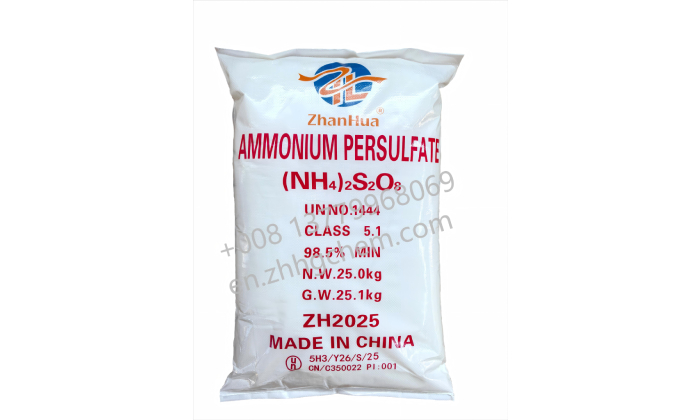The accurate detection of the concentration of Ammonium Persulfate is of great significance for the accuracy of experimental results and the control of industrial production processes. Whether in chemical synthesis in scientific research laboratories or in the manufacturing of coatings, adhesives, and other fields in industrial production, the correct application of concentration detection methods is the key to ensuring the smooth progress of experiments and the orderly operation of production.

I. Significance of Detecting the Concentration of Ammonium Persulfate
Ammonium Persulfate ((NH₄)₂S₂O₈), as a strong oxidant, is widely used in fields such as chemical synthesis, wastewater treatment, and the materials industry. Its concentration directly affects the oxidation efficiency. Insufficient concentration will lead to incomplete reactions, while too high a concentration may trigger side reactions or equipment corrosion. Accurately determining its concentration is of great significance for process optimization, safety control, and environmental protection. For example, in wastewater treatment, the oxidation ability of Ammonium Persulfate is closely related to its concentration. If the concentration is too low, pollutants cannot be effectively degraded, and if the concentration is too high, it may cause damage to the environment and equipment. Therefore, accurately detecting the concentration of Ammonium Persulfate is not only a control of product quality but also a responsibility for production safety and environmental protection.
II. Commonly Used Experimental Methods
1. Iodometric Method (Titration Method)
Principle: Ammonium Persulfate reacts with excessive KI in an acidic condition to generate I₂. Then, Na₂S₂O₃ is used to titrate I₂, and the concentration of Ammonium Persulfate is calculated indirectly.
Specific steps: Accurately weigh a certain amount of Ammonium Persulfate sample (about 0.3g) and dissolve it completely in an appropriate amount of deionized water. Then, add excessive potassium iodide (KI) to the solution and let it stand in the dark for 30 minutes to ensure that Ammonium Persulfate fully reacts with potassium iodide to generate iodine (I₂). Titrate with a 0.1 mol/L sodium thiosulfate standard solution until the solution changes from reddish-brown to light yellow. Add 2 mL of 1% starch indicator and continue titrating until the blue color disappears. According to the volume of sodium thiosulfate consumed during the titration process and combined with the reaction equation, the concentration of Ammonium Persulfate can be calculated.
2. Spectrophotometric Method
The spectrophotometric method is a highly efficient detection method based on the principle of light absorption, characterized by simple operation and fast speed. Its basic principle is based on the characteristic absorption peak of Ammonium Persulfate in the ultraviolet region (λ = 254 nm), and quantification is carried out through a standard curve.
In the experiment, first, a series of Ammonium Persulfate standard solutions with different concentrations need to be prepared, and their absorbance in the ultraviolet region (λ = 254 nm) is measured to draw a standard curve. Then, measure the absorbance of the solution to be tested and calculate its concentration according to the standard curve. The spectrophotometric method has high sensitivity and is particularly suitable for the rapid detection of low-concentration samples.
3. Electrochemical Method
The electrochemical method is a detection method based on electrode reactions, and the concentration of Ammonium Persulfate is determined by measuring the redox current on the electrode. Commonly used electrochemical methods include cyclic voltammetry and polarography.
Cyclic voltammetry determines the concentration of Ammonium Persulfate by applying a changing voltage and measuring the change in the current generated on the electrode. Polarography measures the current at a constant voltage and calculates the concentration according to the magnitude of the current. The advantage of the electrochemical method lies in its high sensitivity and fast response speed, making it suitable for the detection of low-concentration samples.
4. Other Auxiliary Methods
In addition to the above methods, there are some auxiliary methods that can be used for the detection of the concentration of Ammonium Persulfate, such as ion chromatography and conductivity method.
The ion chromatography method injects the Ammonium Persulfate solution into an ion chromatograph and uses the difference in the retention time of different ions in the chromatographic column for quantitative analysis. This method has high separation efficiency and sensitivity and is suitable for the accurate detection of complex samples.
The conductivity method calculates the concentration of Ammonium Persulfate by measuring the conductivity of the solution. This method is easy to operate and is suitable for the rapid and rough detection of high-concentration samples, but its accuracy is relatively low.
III. Selection and Application of Experimental Methods
In actual operation, the selection of the method for detecting the concentration of Ammonium Persulfate needs to comprehensively consider various factors such as experimental conditions, sample characteristics, and detection accuracy.
The iodometric method and the spectrophotometric method perform excellently in scenarios where scientific research laboratories have extremely high requirements for detection accuracy due to their high sensitivity and accuracy. The electrochemical method and the conductivity method, because of their fast detection speed and convenient operation, are more suitable for the need to quickly obtain detection results at the industrial production site.
It is worth noting that high-quality Ammonium Persulfate products are the basis for ensuring accurate and reliable experimental results. Take Fujian Zhanhua Chemical as an example. As a high-tech enterprise specializing in the production of persulfate series products, it has established a good reputation in the industry. The Ammonium Persulfate produced by this enterprise has extremely high purity and stable performance, which benefits from its advanced production process and strict quality control system. Moreover, Zhanhua Chemical has passed a number of international certifications and has won the trust of global customers with its high-quality products and comprehensive services.